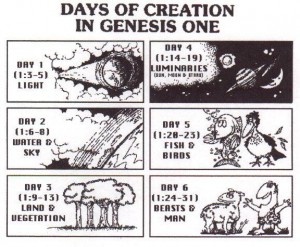“Personally, I’d want to hear a creation story, a story that recounts how the world was formed, how things came to be, for contained within creation stories are relationships that help to define the nature of the universe and how cultures understand the world in which they exist” (King, 10).
In this lesson Dr. Paterson has tasked us with a variety of questions, one of which asks us to examine the similarities and differences in the characteristics of two different creation stories. The first is the story with which I am familiar – that is, the Christian story of creation. The second story is from Thomas King’s creation story in The Truth About Stories. I will compare and contrast these stories, and outline the differences in religious emphasis.
The biblical story of creation is one of great structure and power. The one almighty power of God is creator of all, and step by step the world comes into being, starting with the distinguishing of day from night, light from dark, earth from the seas, and man from woman. God works with his sole power to create what he deems appropriate, satisfied after each day of creation. The story of simple, methodical, and seemingly easy to follow and understand. Simplified and humorous animated versions are available online, allowing for large gross consumption of the story. Although not extremely religious as a child and to this day, the story of Genesis is what I grew up with knowledge about, as I would imagine a large number of people did.
King’s creation story has obvious dramatic differences than the story found in the Bible. King’s story is well, more of a story in a sense, and this allows the reading of it to be a more energetic, narrative read. King successfully intertwines creation with characters, and a fun, lighthearted approach. The religious weight and emphasis in each story is obviously contrasting. Whereas the biblical story of creation is in the hands of God, the story of Charm puts emphasis on the shared efforts and work of all characters to allow for success.
In the post-creation Christian story, Eve eats the apple after being told not to, and the following results is the removal of Adam and Eve from the Garden of Eden. Interestingly, Charm’s fall to earth begins her intrigue and questioning of what is what, and where is where. She is told to not dig so deep, yet she does so anyways.
“Don’t dig too deep, Badger told her.
Mind your own business, Charm told him.
Okay, said Badger, but don’t blame me if you make a mistake.
You can probably guess what happened. That’s right, Charm dug right through to the other side of the world” (King, 13).
Although different stories, and interpretations of creation, both King’s version and that of Genesis share a common foundation. That is, of progression and development. Both stories can be contextualized as the reader wishes, and individuals can take from each story bits and pieces and in a sense, create their own story of creation. The differences in the creative interpretations makes it clear that there is no one story of creation, nor is there a “right” and “wrong”.
Thank you for reading,
Gillian
Works Cited
King, Thomas. “The Truth About Stories, A Native Narrative”. Canadian Broadcasting Corporation. Toronto. 2003.
